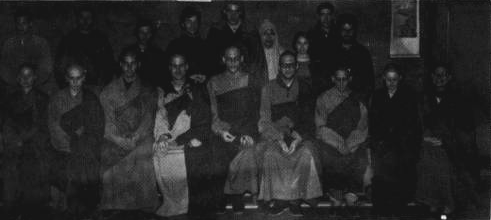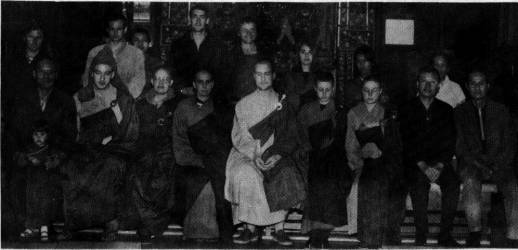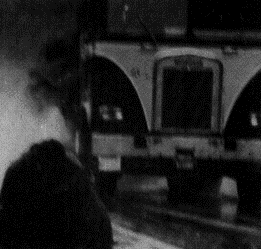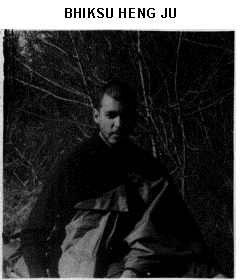News from
the Dharma Realm

On April 23, 1974, Bhiksu Heng Shoou departed from Gold Mountain Dhyana
Monastery on his way to Tz’u Hsing Monastery in Hong Kong where he will
translate the Surangama Sutra and protect the translation work from those
who would see it fail. Here he is shown with some of the Gold Mountain
assembly who were on hand to wish him a sage voyage. (Seated center)

Upasaka Chu Fei (seated left) is welcomed by some of the four-fold assembly of cultivators at Gold Mountain during his recent visit to San Francisco. See story BODHEDRUM EDITOR IN CHIEF VISITS GOLD MOUNTAIN
SEEING DHYANA CULTIVATOR HENG SHOOU OFF TO THE EAST
Written on the occasion of Dhyana-cultivator Heng Shoou's departure for Hong Kong with the hope that he will take special care to protect the translation efforts from outside interference.
Alas! How exceedingly unfortunate we are to have been born in this age of fierce fighting. Should we persist in creating the karma of violence, who knows where it will end? Bhiksu Heng Ch'ien and the others, while translating in Hong Kong, have encountered all manner of obstacles which have delayed the work. For this reason I send you to Hong Kong to assist in its completion.
Magnificent is the responsibility of gods and sages, but many demons lurk about the works of goodness, and deeds of excellence are difficult to finish.
Rouse
your spirits: Remain unruffled in the face of opposition. No matter how
bitter the conditions, do not change. Should adverse circumstances arise,
meet them with strong samadhi, patience, and reason. If, even when being
reviled or beaten, your heart remains unmoved, then the Buddhas and
Bodhisattvas of the ten directions will praise you with delight.
I
leave you this verse:
The
demons are strong and the Dharma's weak in the time of strength in fighting.
Part
the clouds; see the sun and the clear sky will appear.
Wearing
the armor of vigor, destroy the five turbid realms;
With
the mai1 of irreversibility, transform the trichiliocosm.
When
opposition comes, receive it with the paramita of patience.
Blow
the magnificent jeweled conch, startle the deaf and dumb,
And
then the sage's teachings will endure for a billion years.
April
23, 1974
Hsuan
Hua
(Translated
by Bhiksuni Heng Yin)


